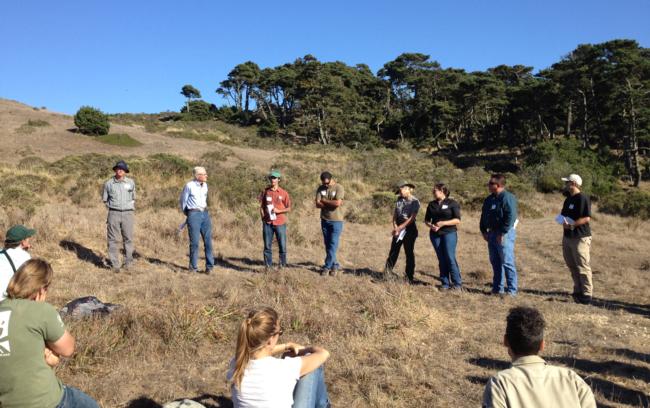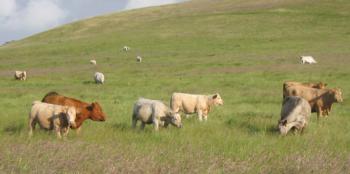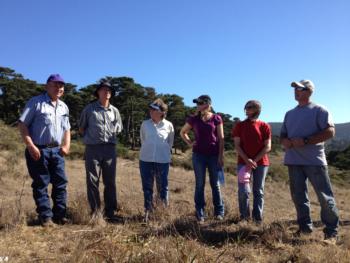Home on the range(land): ranches, parks, and biodiversity

Rancher Tim Koopmann began the meeting by emphasizing the importance of working partnerships between ranchers and resource managers. “We [ranchers] graze for optimum resource enhancement” Koopmann reminded participants.
Dr. Grey Hayes, coordinator of Elkhorn Slough Coastal Training program, kicked off the day’s presentation with the provocative question: Why do we care about California’s coastal prairie? Hayes argued that California’s coastal grasslands are economically, socially and environmentally important ecosystems for reasons that all participants and community members could rally behind. Grasslands provide, among other services: erosion control, agricultural production, tourism, conservation, and habitat.

Researchers shared results illustrating the impacts of grassland conversion to shrubland on rare plant, bird, and butterfly populations and habitat succession. In many cases, removing grazing led to decreased, shifted, or altogether missing populations. For example, PRNS staff described how exclusion of grazing from a population of the federally endangered Sonoma shortawn foxtail (Alopecurus aequalis var. sonomensis) led to the demise of that population, and researchers’ presentations explained how grazing benefits grassland birds and rare butterflies by maintaining the grassland habitat and preventing buildup of too much biomass. Every study presented suggested that a “one-size-fits-all” management plan won’t work, and that ranchers and land managers will benefit from one-on-one, site-specific recommendations.
Speakers explained that PRNS is part of California’s Mediterranean coastal climate, which is one of the most biodiverse places on the planet with acres of working agricultural landscapes. Devii Rao, Rangeland Management Specialist for Point Reyes National Seashore, described the inspiring knowledge and history of the land present in the ranching community in Point Reyes. Rao’s goals for the meeting were to find win-win outcomes for the park service and ranchers that preserve the physical attributes and features, contribute to historic districts, support historic dairy and beef ranching, and enhance traditional cultural associations with land and the ranching community. She also hoped all participants would gain a better understanding of what creates a good balance between grassland and shrubland.

John Taylor of Bivalve Dairy also shared his experience with brush control and emphasized that “If you take away something from the pasture, something will come back in its place.” He urges ranchers and land managers to replace the shrubs with something they would like to be there. Taylor has ripped out, chipped and burned the coyote brush on his dairy. Taylor concluded that “It all comes down to having a plan” based on your forage needs.
Burning was discussed as a potential strategy for managing shrubs where grazing is not feasible or sufficient, but it must be done properly and with good control measures.
Participants walked away with a renewed sense of the importance of grassland and coastal prairie habitat and resources, as well as the challenges of shrub management for ranchers and other land managers. Participants emphasized the need for better community education and understanding of grazing as an important land and shrub management tool. The details of when, how and where grazing should be used are not always clear. It is clear, however, that the future for Marin County working landscapes including Point Reyes National Seashore will continue to be dotted with grazing animals munching away for “optimum resource enhancement.”
By Juliet Braslow



